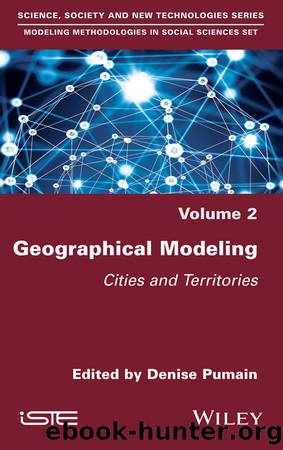Geographical Modeling by Denise Pumain

Author:Denise Pumain [Denise Pumain]
Language: eng
Format: epub
Publisher: Wiley-ISTE
Published: 2020-04-27T16:00:00+00:00
4.3.3. Hierarchizing the interaction processes between agents
Hierarchizing interaction mechanisms between agents is an important step in most of the modeling approaches but is rarely mentioned in the published results of the model. A notable counterexample is the presentation of the Sugarscape model in the book by J. Epstein and R. Axtell (1996). Starting from a simple model, the authors describe, in successive chapters, the increasing complexity of behaviors available to the simulated agents, from static agents harvesting a local resource to mobile, gendered agents capable of building up food stocks and transmitting them, trading, reproducing, and polluting. In the example of the MARIUS model simulating the differentiated evolution of city populations in the former Soviet Union (Cottineau et al. 2015b), the interaction mechanisms between city–agents are hierarchized from the most general one (i.e. exchanging value according to a gravity model) to the one most particular to the study space (i.e. socialist economic planning and the exclusive specialization of cities in the production of goods for the entire country). In between, we find the mechanisms of territorial equalization, the memory of exchanges, or the diversification of urban functions (see axis 1 in Figure 4.2). This hierarchization has enabled us to choose which mechanisms to implement and evaluate first.
Download
This site does not store any files on its server. We only index and link to content provided by other sites. Please contact the content providers to delete copyright contents if any and email us, we'll remove relevant links or contents immediately.
Thinking Better by Marcus du Sautoy(607)
Invention by James Dyson(559)
Wanting by Luke Burgis(544)
The Ten Equations That Rule the World by David Sumpter(522)
Concepts of Space by Jammer Max;(520)
Merchants of Doubt by Erik M. Conway(512)
How We Got to Now by Steven Johnson(508)
The Smallest Lights in the Universe by Sara Seager(449)
God and the Multiverse by Victor J. Stenger(447)
Factfulness by unknow(438)
Ancient Knowledge Networks by Eleanor Robson;(409)
Floods, Famines, and Emperors: El Nino and the Fate of Civilizations by Brian Fagan(397)
On Creativity by Bohm David(396)
The Science of Being Lucky: How to Engineer Good Fortune, Consistently Catch Lucky Breaks, and Live a Charmed Life by Peter Hollins(388)
The Oxford Handbook of Philosophy of Mathematics and Logic by Stewart Shapiro(388)
The Scientist and the Psychic by Christian Smith(384)
Flood by Design (Design Series) by Mike Oard(368)
The Surrender Experiment by Michael A. Singer(364)
Science by John Gribbin(359)
